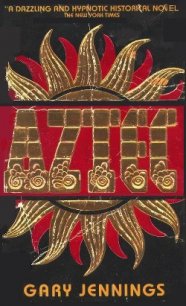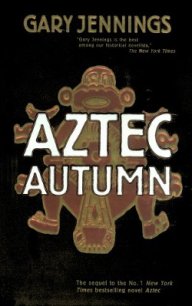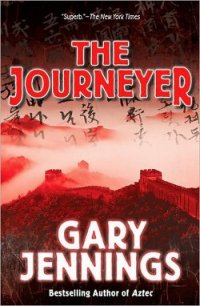Aztec Blood - Jennings Gary (книги онлайн бесплатно серия .txt) 📗
"If you pull out the arrow that way, you will tear his insides and he will bleed to death."
The speaker, a Spaniard about forty years old and dressed like a wealthy merchant, knelt and examined the wound. I heard someone call him "Don Julio" when he instructed men to help him move the injured man.
"Move him over here. Stand back," he told those of us crowding around.
Always fascinated by medicine, I helped Don Julio and two others move the wounded man behind the line of merchant tents so he would be out of the sight and path of people.
Don Julio knelt and examined the arrow wound.
"What position were you in when you were shot?" Don Julio spoke Spanish with a slight accent, and I recognized that he was probably Portuguese. Many Portuguese had come to the New World after the Spanish king inherited the throne of that country.
"Standing up."
"Were you straight up? Standing tall? Or bent a little?"
He groaned. "Maybe bent a little."
"Straighten out his legs," he told us.
When we had the man's legs straight, he had us do the same for the upper body. Once he had the man in the position that most likely reflected what he was like when the arrow struck, Don Julio carefully examined and probed the area when the arrow met the flesh.
The man's friend impatiently snapped, "Pull it out before he dies." He spoke in the rough Spanish of rural indios.
I answered the man. "He has to remove it in the same line that it entered, or he will create a bigger wound."
By removing the arrow in the same path it entered, he would reduce tearing more flesh. The man already had a wound that would probably kill him no matter how carefully the arrow was removed. Increasing the size of the wound would reduce his chance of surviving.
Don Julio glanced up at me. I had inadvertently spoken in my polished Spanish rather than deliberately mispronouncing words as I had done with Sancho.
He tossed me a half-reale. "Run to a cloth seller. Get me a piece of clean white cotton."
I returned quickly with the piece of cloth. I did not offer the change.
After he removed the arrow, Don Julio dressed the open wound, cutting pieces of the cloth to create a cover for it.
"This man cannot walk or even ride a mule," he told the indio's friend. "He has to lie still until the bleeding stops." He took aside the man's friend. "He has only a small chance of survival, but he will not survive at all if you move him. He can't be moved for at least a week."
I saw the friend exchange looks with another man. Neither of the two men appeared to be indio farmers. They had the look of leperos, perhaps men hired from the streets by merchants to bring merchandise to or from the fair. The chances of them staying around until the man could travel were not good. As soon as the fair broke up, they would throw dice for his boots and clothes, smash his skull, and drag him into the woods for wild animals to dispose of.
As the crowd around the man moved away, I heard a man look in the direction of Don Julio and whisper contemptuously to another, "Converso."
I knew this word from discussions with Fray Antonio. A converso was a Jew who had converted to Christianity rather than leave Spain or Portugal. Sometimes the conversion had taken place generations before, but the blood taint was still there.
The fact that this wealthy doctor, which is what I took him to be, also had a blood taint naturally endeared him to me.
I left the fair and walked toward a mound that had once been a small temple for a military outpost or a merchant's rendezvous. I sat for a while deep in thought about the predicament I was in with Sancho and Mateo. I was less worried about myself than I was of any harm coming to the Healer. I had of course lied when I told Sancho that the Healer was my father, but in a way there was truth to it since I thought of both him and Fray Antonio like a father.
I had no illusions about what my reward would be once I had completed the task for Sancho. Both the Healer and I would be killed. Ay, it was not a happy situation. The Healer moved very slowly and would go nowhere without his dog and his donkey. My only recourse was to await the opportunity to stick a knife in Sancho's fat gut and hope that Mateo would not harm the Healer even if he cut off my head.
I spotted Aztec picture writing engraved in stone on the side of the wall of the ruins, and I moved aside brush to read it. I had learned to read Aztec picture writing from the Healer, who showed me pieces of paper with writing on it that was done before the conquest. He told me that the empire centered at Tenochtitlan required a vast amount of paper to run, for its army, merchants, government administration, and that hundreds of thousands of sheets of blank paper were received each year as tribute from vassal states.
The fray had also been interested in Aztec picture writing and paper. He had been excited once when another fray showed him a piece of it. Paper was made by soaking the bark of certain fig trees in water until the fiber separated from the pulp. The fiber was pounded on a flat surface, folded over with a sticky substance in between, flattened more, and then smoothed and dried. Good quality paper had a whitish substance spread over it.
A bundle of these papers bound together was called a codex by the Spanish, being a Latin word for a type of book. Only a few indio codices had survived the fanatical zeal of the Christian priests, Fray Antonio told me. Picture drawings were done in bright colors—red, green, blue, and yellow—and having seen a few pages possessed by the Healer, I can only envision that the codices saved from the ravages of the priests must be works of great beauty.
Aztec writing itself was nonalphabetical, picture writing much like the Egyptians used. A series of pictures had to be read together to reveal the message or story. Some objects were represented by a miniature of the object, but most situations required something more complex: a black sky and closed eye was night, a wrapped mummy figure was a symbol of death, seeing was expressed by an eye drawn away from the viewer.
The picture writing inscribed on the wall near the fair showed an Aztec warrior in full battle dress pulling the hair of a warrior from another city—thus war and battle were raging. An Aztec king or noble whom I could not identify, although I knew that each Revered Speaker had a personal symbol, was speaking. This was indicated by a little scroll coming from the mouth of the speaker. I had also seen it expressed as a wagging tongue. After he spoke, Aztec warriors marched, shown by footprints, toward a temple atop a mountain. The temple was burning, indicating that the tribe that owned the temple had been conquered.
As I read the tale aloud in Spanish, which was the language I thought in, I was startled when I caught another presence out of the comer of my eye. Don Julio was standing nearby watching me.
"You can read Aztec sign language?"
Pride loosened my tongue. "A little. The inscription is a boast—and a warning. Probably put here by the Aztecs to impress upon traveling merchants of other tribes what happens to towns that don't pay their tribute."
"Very good. I also can read the pictures, but it's almost a lost art." He shook his head. "My God, the history, the knowledge, that was lost when the frays burned them. The library at Texcoco was enriched with literary treasures gathered by the great king, Nezahualcoyotl. It was the New World equivalent of the great library of antiquity at Alexandria. And it was destroyed."
"My Aztec name is Nezahualcoyotl."
"An honorable name, even if it labels you a hungry coyote. Your namesake was not just a king, but a poet and writer of songs. But Like so many kings, he also had human vices. Lusting for the wife of one of his nobles, he sent the man into battle with secret orders to his captains to see that the man was killed."




